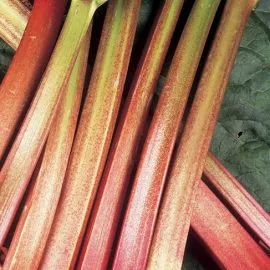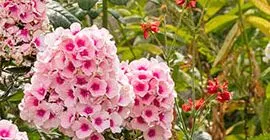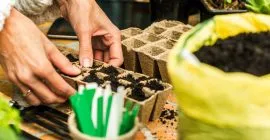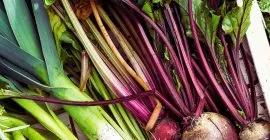Every garden should have at least one clump of rhubarb for early summer puddings.
Unwins sell a specially selected variety called Victoria, which produces succulent pink stems with a delicious tart flavour.
Rhubarb takes a whole year to get started, but is a great plant that requires minimal work and can be harvested year after year. It’s also excellent in a crumble!
Also read our guide on how to force rhubarb.
Recipes
Step 1
Planting Rhubarb
Choose a spot where your rhubarb has room to mature and grow. An established clump could measure up to a metre (2-3 feet) in diameter.
Rhubarb is a heavy feeder and needs soil rich in organic matter. Dig over the soil thoroughly and incorporate Gro-Sure Farmyard Manure into the ground. Be generous, this will provide a slow and steady release of nutrients to your plants as they mature.
Dig a hole, twice the size and depth of the rhubarb crown and fill the base of the hole with New Horizon Veg Compost
Place the rhubarb crown in the base of the hole with the roots at the bottom and the dormant shoots at the top.
Cover over with a generous layer of New Horizon Veg Compost and water thoroughly.
Mulch over the top with a layer of Gro-Sure Farmyard Manure.
Step 2
Feeding Rhubarb
Feed the crowns once established with Gro-Sure All Purpose Plant Food or if you are feeding a lot of plants in the garden you could use Gro-Sure All Purpose Soluble Plant Food which offers good value when feeding a large number of plants. Ensure plenty of water is applied during growing as rhubarb is thirsty as well as hungry.
Avoid harvesting stems in the first year of growth as this will weaken your plant. Instead nurture it by watering and feeding throughout the season so the underground structure establishes well. If your plant starts to make a flower spike, cut this off as soon as you see it as close to the crown as possible.
Over the winter your plant will die back. Cover with a mulch of Gro-Sure Farmyard Manure to protect it from frost.
Step 3

The following year, your rhubarb will be ready to be harvested from spring to early summer, unless it has been forced (an upturned bucket with large holes in the bottom is ideal), which will make it ready to harvest a few weeks earlier. The bucket can be secured over the plant using small sandbags or large stones.
In year two you can harvest a small number of stems for the first two to three weeks of growth. Don’t ever cut off more than half of the stems, or you will weaken the plants. In the third year of growth you can harvest stems for 2-3 months early in the season. Choose fat, pink stems where the leaf is fully formed but not yet aged, for the tastiest rhubarb.
Rhubarb is best cooked straight from the garden but can be stored by freezing (raw or cooked) or bottling.




